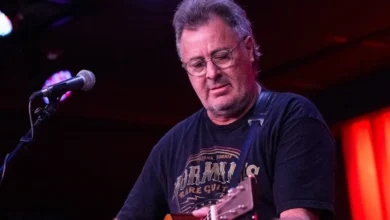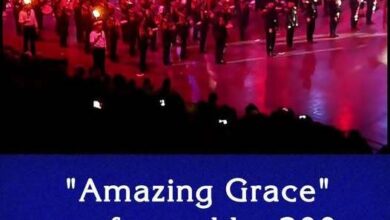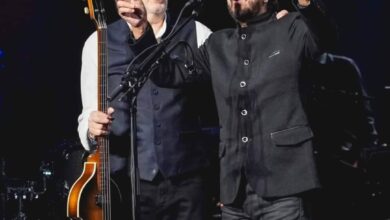This Popular Dance From The 1950s, Can You Remember It Today
In February 1958, “The Stroll” penetrated the consciousness of American teens, transforming high school gyms and sock hops into lively epicenters of youthful revelry. Emerging from the rhythms of African American music and dance traditions, this line dance encapsulated the exuberance and carefree spirit characteristic of rock ‘n’ roll’s formative years. With its catchy rhythm and playful structure, “The Stroll” invited everyone to join in, reflecting a sense of community that was pivotal in shaping adolescent culture during this transformative decade.
The simplicity yet engaging format of “The Stroll” was central to its appeal. Arranged in two parallel lines facing one another, participants would take turns gliding down the aisle created between the lines, striking their best poses and showcasing their signature moves. This dynamic format not only encouraged group participation but also allowed individuals to shine, infusing personality and flair into their performances. As teenagers nationwide began to adopt “The Stroll” at local gatherings, it quickly grew from a regional fad into a national craze, bridging various social, racial, and economic backgrounds in a way that few other cultural activities could at that time.
The rise of television played a critical role in the proliferation of “The Stroll.” Shows like Dick Clark’s “American Bandstand” were instrumental in popularizing the dance. Clark, as a charismatic host, showcased the latest musical acts and teenage dancers, creating a platform where trends spread like wildfire. Teen viewers found themselves captivated by the infectious energy of the dancers and the catchy tunes accompanying their movements. This twofold appeal made “The Stroll” not only a dance but also an essential part of a larger cultural movement that characterized the 1950s.
The song “The Stroll,” performed by the Canadian vocal group The Diamonds, further solidified the dance’s place in the hearts of American youth. Known for their lively harmonies and the signature doo-wop sound, The Diamonds brought an infectious joy that perfectly matched the exuberant nature of the dance. Their lead singer, Dave Somerville, lent his robust baritone to the track, creating a captivating atmosphere that inspired listeners to get up and dance. The combination of a catchy tune and the engaging dance made “The Stroll” a staple in record collections and at dance parties, where it became synonymous with fun and youthful expression.
Beyond mere entertainment, “The Stroll” became a vital means of self-expression for teenagers grappling with their identities during a time of significant societal change. The 1950s saw the emergence of a distinct youth culture, characterized by a rejection of traditional norms and an embrace of new ideologies. “The Stroll” allowed teenagers to break free from conventions, showcasing their individuality while simultaneously participating in a collective experience. The communal aspect of the dance provided a sense of belonging, reinforcing connections among peers who were navigating the complexities of adolescence in a world that felt both exhilarating and uncertain.
The social impact of “The Stroll” cannot be overstated. In an era marked by segregation and division, the dance became a unifying force that brought together kids from various backgrounds. Nightclubs and community centers became melting pots where people who otherwise may not have interacted found common ground on the dance floor, fostering a spirit of camaraderie that cut across barriers of race and class. Such connections were essential in promoting a culture that celebrated diversity and mutual enjoyment, setting a precedent for future generations.
As the years progressed, “The Stroll” evolved but retained its spirit. Dance moves birthed from the 1950s have inspired various recreations in modern pop culture, showcasing an enduring appreciation for its roots. Its catchy rhythm has been sampled and revisited in different musical genres, reflecting a nostalgic yearning for the simplicity and joy of past eras. In high school dances, community events, and even family gatherings, sequences reminiscent of “The Stroll” can still spark moments of joy and connection among participants.
The influence of “The Stroll” extended beyond just social gatherings; it was a representation of the burgeoning rock ‘n’ roll culture that set the stage for subsequent musical movements. As artists and bands continued to experiment with sounds, dance forms, and cultural expressions, the legacy of dances like “The Stroll” served as a reminder of how music can bring people together, enabling them to embrace a shared moment of happiness. Such occurred during the transition into the 1960s and beyond, when the lines of popular music and cultural expression would continue to blur.
As we reflect on the dance craze phenomena of the late 1950s, it is crucial to acknowledge the artists whose contributions made an indelible mark on the cultural landscape. The Diamonds, with their polished harmonies and upbeat melodies, played a pivotal role in bringing “The Stroll” to mainstream audiences. Their continued influence can be traced through various musical genres, as they cemented themselves as key figures in the story of musical innovation of the time.
In summary, “The Stroll” stands not just as a popular dance but as a symbol of the vibrant youth culture of the 1950s—a touchstone of an era where music, dance, and a spirit of community converged to create lasting memories. The legacy of this dance, powered by the rhythm of rock ‘n’ roll and the melodies of groups like The Diamonds, endures as a reminder of the power of music to transcend barriers and create bonds among diverse individuals, fostering an appreciation for the joy and spontaneity that dance brings to life.
?si=CbHsPwTM-VodZAIG





